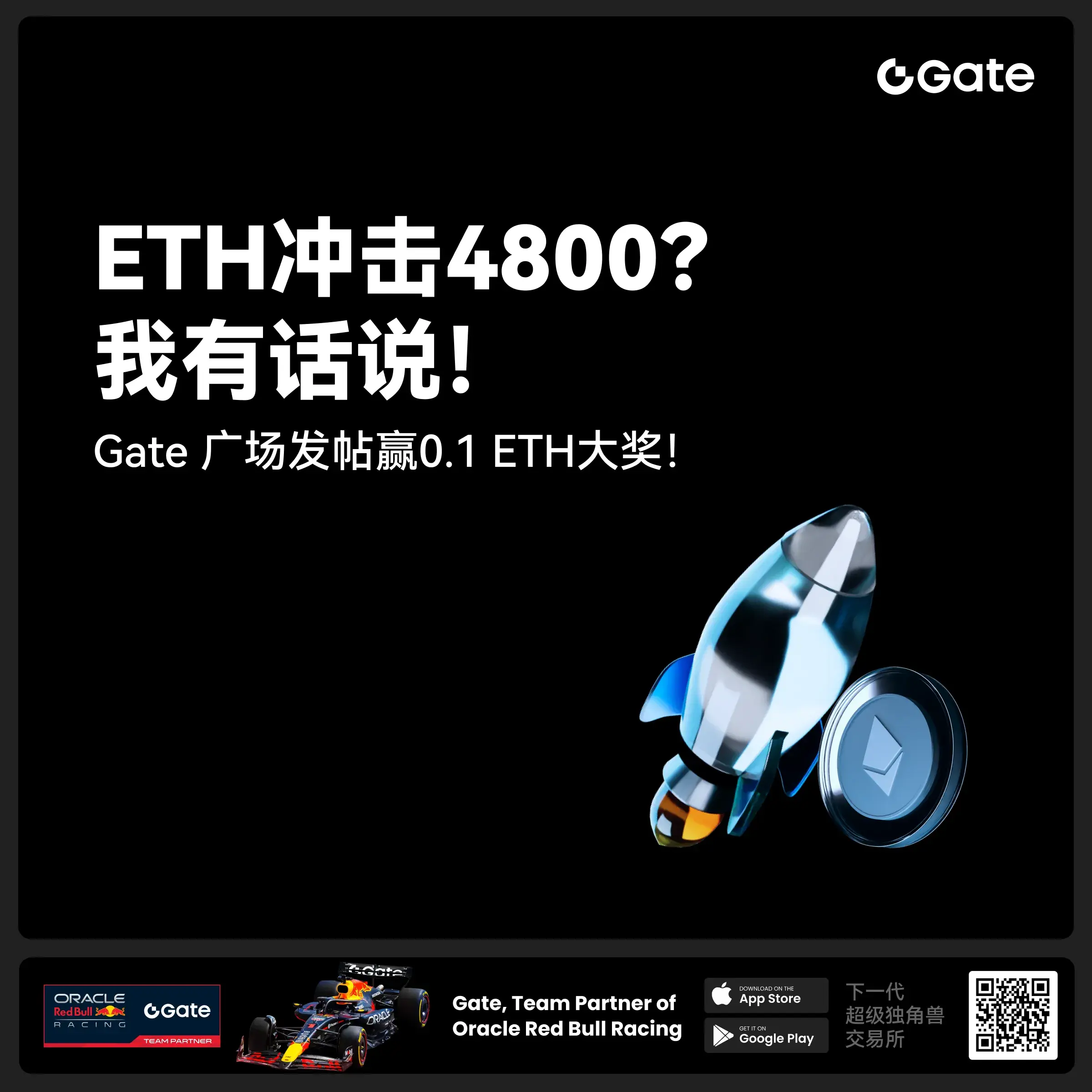更多
- 话题1/3
1345 热度
120 热度
11457 热度
20213 热度
14958 热度
- 置顶
- 🎉Gate 2025 上半年社区盛典:内容达人评选投票火热进行中 🎉
🏆 谁将成为前十位 #Gate广场# 内容达人?
投票现已开启,选出你的心头好
🎁赢取 iPhone 16 Pro Max、限量周边等好礼!
📅投票截止:8 月 15 日 10:00(UTC+8)
立即投票: https://www.gate.com/activities/community-vote
活动详情: https://www.gate.com/announcements/article/45974
- 📢 #Gate广场征文活动第二期# 正式启动!
分享你对 $ERA 项目的独特观点,推广ERA上线活动, 700 $ERA 等你来赢!
💰 奖励:
一等奖(1名): 100枚 $ERA
二等奖(5名): 每人 60 枚 $ERA
三等奖(10名): 每人 30 枚 $ERA
👉 参与方式:
1.在 Gate广场发布你对 ERA 项目的独到见解贴文
2.在贴文中添加标签: #Gate广场征文活动第二期# ,贴文字数不低于300字
3.将你的文章或观点同步到X,加上标签:Gate Square 和 ERA
4.征文内容涵盖但不限于以下创作方向:
ERA 项目亮点:作为区块链基础设施公司,ERA 拥有哪些核心优势?
ERA 代币经济模型:如何保障代币的长期价值及生态可持续发展?
参与并推广 Gate x Caldera (ERA) 生态周活动。点击查看活动详情:https://www.gate.com/announcements/article/46169。
欢迎围绕上述主题,或从其他独特视角提出您的见解与建议。
⚠️ 活动要求:
原创内容,至少 300 字, 重复或抄袭内容将被淘汰。
不得使用 #Gate广场征文活动第二期# 和 #ERA# 以外的任何标签。
每篇文章必须获得 至少3个互动,否则无法获得奖励
鼓励图文并茂、深度分析,观点独到。
⏰ 活动时间:2025年7月20日 17
- 🧠 #GateGiveaway# - 加密算术题挑战!
你能解出这道加密题吗?
💰 $10 合约体验券 * 4 位获奖者
参与方式:
1️⃣ 关注 Gate广场_Official
2️⃣ 点赞此条动态贴文
3️⃣ 在评论中留下你的答案
📅 截止时间:7 月 22 日 12:00(UTC+8)
- 📢 ETH冲击4800?我有话说!快来“Gate广场”秀操作,0.1 ETH大奖等你拿!
牛市预言家,可能下一个就是你!想让你的观点成为广场热搜、赢下ETH大奖?现在就是机会!
💰️ 广场5位优质发帖用户+X浏览量前5发帖用户,瓜分0.1 ETH!
🎮 活动怎么玩,0门槛瓜分ETH!
1.话题不服来辩!
带 #ETH冲击4800# 和 #ETH# 在 广场 或 K线ETH下 围绕一下主题展开讨论:
-ETH是否有望突破4800?
-你看好ETH的原因是什么?
-你的ETH持仓策略是?
-ETH能否引领下一轮牛市?
2. X平台同步嗨
在X平台发帖讨论,记得带 #GateSquare# 和 #ETH冲击4800# 标签!
把你X返链接提交以下表单以瓜分大奖:https://www.gate.com/questionnaire/6896
✨发帖要求:
-内容须原创,字数不少于100字,且带活动指定标签
-配图、行情截图、分析看法加分,图文并茂更易精选
-禁止AI写手和灌水刷屏,一旦发现取消奖励资格
-观点鲜明、逻辑清晰,越有料越好!
关注ETH风向,创造观点价值,从广场发帖开始!下一个牛市“预言家”,可能就是你!🦾🏆
⏰ 活动时间:2025年7月18日 16:00 - 2025年7月28日 23:59(UTC+8)
【立即发帖】 展现你的真知灼见,赢取属于你的ETH大奖!
- 🎉【Gate 3000万纪念】晒出我的Gate时刻,解锁限量好礼!
Gate用户突破3000万!这不仅是数字,更是我们共同的故事。
还记得第一次开通账号的激动,抢购成功的喜悦,或陪伴你的Gate周边吗?
📸 参与 #我的Gate时刻# ,在Gate广场晒出你的故事,一起见证下一个3000万!
✅ 参与方式:
1️⃣ 带话题 #我的Gate时刻# ,发布包含Gate元素的照片或视频
2️⃣ 搭配你的Gate故事、祝福或感言更佳
3️⃣ 分享至Twitter(X)可参与浏览量前10额外奖励
推特回链请填表单:https://www.gate.com/questionnaire/6872
🎁 独家奖励:
🏆 创意大奖(3名):Gate × F1红牛联名赛车模型一辆
👕 共创纪念奖(10名): 国际米兰同款球员卫衣
🥇 参与奖(50名):Gate 品牌抱枕
📣 分享奖(10名):Twitter前10浏览量,送Gate × 国米小夜灯!
*海外用户红牛联名赛车折合为 $200 合约体验券,国米同款球衣折合为 $50 合约体验券,国米小夜灯折合为 $30 合约体验券,品牌抱枕折合为 $20 合约体验券发放
🧠 创意提示:不限元素内容风格,晒图带有如Gate logo、Gate色彩、周边产品、GT图案、活动纪念品、活动现场图等均可参与!
活动截止于7月25日 24:00 UTC+8
3
Crypto’s path to legitimacy runs through the CARF regulation
Opinion by: Alice Frei, head of security and compliance at Outset PR
More than 60 countries have signed on to CARF (Crypto-Asset Reporting Framework), marking 2027 as the year crypto goes fully on the grid, tax-wise.
First up are the UK and the EU. Singapore, the UAE, Hong Kong and the US are on deck next, with plans to roll out in 2028
Behind the scenes, crypto platforms are quietly rebuilding in response. To the most privacy-conscious users and developers, the irreversible end of crypto’s resistance to surveillance is unwelcome news
What appears to be regulatory capture on the surface, however, is actually the framework that sets conditions for the industry’s responsible evolution.
The market implications of CARF
For the longest time, moving crypto around felt like magic. Anyone could shoot over some funds, flip tokens or cover expenses with USDT on the go, with no banks, no forms and definitely no questions asked. The frictionless freedom made crypto feel like the future. That chapter is now coming to a close
What CARF does is pretty straightforward — it makes platforms track and report who is moving what, where and how much, whether that’s exchanging tokens, cashing out or spending big.
As usual, though, there is a nuance. Gone are the days when crypto transactions were reported once a year. With CARF, tax transparency is becoming near-instant
CARF applies to what’s called reporting crypto-asset service providers — exchanges, brokers, ATM operators and even solo entrepreneurs who regularly help people move funds. For the first time in history, non-custodial services and DEXs are on the hook, too
All jurisdictions joining CARF must pass domestic legislation a calendar year before reporting occurs. The EU member states must transpose these new rules into national legislation by the end of 2025 so that most provisions become effective starting Jan. 1, 2026
For crypto service providers, the direction is crystal clear: platforms that used to ignore reporting now have to build it in. It’s subtle, but it sticks.
Crypto is moving from the edges of the system into the system itself, bringing in more checks, records and accountability. CARF doesn’t slam the door shut, but it does make sure someone’s watching the hallway.
A real stress test for crypto
For years, crypto operated in a gray zone. Not illegal, just unobserved. CARF is finally bringing some structure to the market that has grown too big to stay in the dark
At the end of the day, global tax evasion still drains around $427 billion a year from public coffers. With so much value moving fast and quietly, regulators saw a black hole, and CARF is their answer
Yes, the framework erodes the core appeal of crypto, but let’s not sugarcoat it. CARF doesn’t kill innovation. CARF lays the foundation for something the industry has long sought; it enables legitimacy
Related: Switzerland greenlights sharing crypto tax info with 74 nations
Institutional players have been wary of entering crypto markets in part because of regulatory uncertainty. A standardized, global reporting reduces that caution. Not to mention, the big capital participation helps stabilize price volatility.
For everyday users, CARF will ultimately make tax reporting as easy as pie. Once platforms share transactional data automatically to tax authorities, crypto people will spend less time tracking gains, losses and liabilities manually.
Crypto is growing up, and that comes with tradeoffs. Some old freedoms won’t feel quite the same: platforms will start to ask questions, some processes will get longer and some wallets will feel a little less invisible. But that doesn’t mean it’s the end
No one’s shutting off access or banning crypto services. New expectations are settling in: about what platforms need to collect, what gets flagged, what gets stored and what gets shared. It’s about whether the space can stay true to what made it powerful while learning to live with rules.
Preparing for an inevitable reality
The upfront compliance burden will be heavy for platforms. Legal advice, infrastructure, and staff training all take sufficient financial injections. It will come as no shock if providers inflate user fees, at least at first, to reimburse these costs.
Some platforms may even restrict services in jurisdictions with early adoption timelines or exit markets altogether. In the medium to long run, however, CARF may accelerate the industry’s professionalization.
Legal clarity will invite multi-year investment. Users will benefit from stronger protections. Providers embracing the framework now will see a competitive advantage.
Those who didn’t think about transparency might start to check if their go-to platforms are CARF-aware, keep detailed transaction records and seek guidance from crypto-native tax advisers. Even crypto veterans are not immune to unpleasant surprises when disputes arise and audits begin
Opinion by: Alice Frei, head of security and compliance at Outset PR.
This article is for general information purposes and is not intended to be and should not be taken as legal or investment advice. The views, thoughts, and opinions expressed here are the author’s alone and do not necessarily reflect or represent the views and opinions of Cointelegraph.